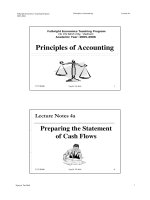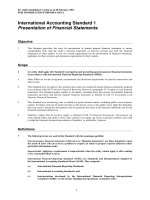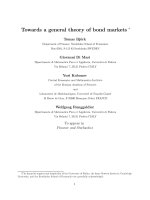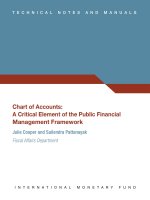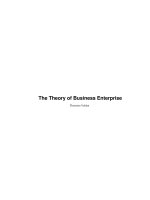business accounting volume i theory of accounts
Bạn đang xem bản rút gọn của tài liệu. Xem và tải ngay bản đầy đủ của tài liệu tại đây (19.79 MB, 468 trang )
THE LIBRARY
OF
THE
UNIVERSITY
OF CALIFORNIA
LOS
ANGELES
BUSINESS
ACCOUNTING
Harold Dudley Greeley, C.P.A., Editor
Volume I —Theory of Accounts
By Harold Dudley Greeley
II
—
Constructive
Accounting
By George E. Bennett
III—Cost Accounting
By DeWitt Carl Eggleston
IV
—Advanced and Analytical
Accounting
By
Henry C.
Cox
V
—Illustrative Accounting
Problems
By Charles
F.
Rittenhouse
and
Harold Dudley Greeley
Business
Accounting
VOLUME I
HEORY OF
ACCOUNTS
By
HAROLD
DUDLEY GREELEY, LL.B.
Certified Public
Accountant; Member of the New
York
Bar;
Member of
National Association
of
Cost
Accountants; Mem-
ber of
American Institute
of
Accountants;
New
York Manager
of the Walton School of
Commerce; Formerly,
Lecturer
on
Accounting,
Columbia University,
New York
Third
Printing
NEW YORK
THE RONALD PRESS
COMPANY
1921
400G6
Copyright,
1920,
by
The
Ronald
Press
Company
All
Rights
Reserved
EDITORIAL
PREFACE
Library
HF
%l\
Gflb
i/.l
Ten years
ago almost
any
contribution
to
the
liter-
ature
of
accountancy would have
been
welcomed.
Today, however, with
the
increasing
number of
excel-
lent publications, it is
incumbent
upon
one who puts
\
forth
a
new accounting
work
to
justify
his action.
N
Much
more is it necessary
to
explain
the publication
of
a
set
of accounting books. Hence
it is desirable to
1
^
state
at
the
outset
the purpose
of
"Business Account-
-i
ing" and to
outline its
scope
and
general methods
of
presentation.
H
While many books have been published
on account-
'^
ing
topics,
in
almost every
case they are unrelated vol-
^
umes.
In
some
few
instances,
a
volume
on accounting
'0
has logically followed another by
the same author, but
with
these
few
exceptions every
one
published has
been
2
written without connection
with,
or
adjustment
to,
any
^
of those already
existing. Under these
conditions,
the
student of accounting,
to get
any connected and logical
knowledge
of
his
subject,
must
find
one
of his
books
here, another
there,
a
third somewhere else, and
bridge
over
the gaps
between them as best he may.
The
proc-
ess is difficult, and the accounting
knowledge
he
obtains
is
not
always
well
co-ordinated and logically developed.
The
volumes of "Business Accounting"
are
intended
to meet
this
situation. They
cannot,
it is true,
provide
a
course
of
study in the sense that prescribed readings
are
recommended,
written
answers
to
questions required,
and
personal
instruction
given. Neither
do
they con-
iii
iv
EDITORIAL
PREFACE
stitute an
encyclopaedia of unconnected
and
isolated
articles.
Rather are they an
attempt
to
present in
simple, non-technical
language the basic principles
of
account-keeping and
their application
to
various lines
of business,
together
with general directions
for prepar-
ing, analyzing, and
interpreting accounting statements.
One
who starts
at
the
beginning of Volume
I and
works
faithfully through to
the
end of
Volume IV,
and
then
solves the
problems
and
examines the
solutions of
Volume
V, should acquire some real understanding of
the theory
and practice
of accounts
—a knowledge
that,
supplemented
by
experience, should
enable him
success-
fully
to
stand the test
of practical work
in any ordinary
business
office
and
furnish
a
foundation for going as
much
further into the
study of
accountancy
as he may
desire.
It may
be
noted
in
passing that the volumes
of
"Business Accounting" have
been
indexed
in
such a
way
as
to provide many of the
features
of an encyclo-
paedia, so that the
person desiring
the
practice
on
a
particular
point or
accounting ideas of suggestive
value
in particular lines of industry will be able
to
use the set
to
advantage.
Taking up the volumes of the
set in
order—
Volume
I presents the fundamental
principles
of account-keep-
ing
and
statement preparation. Upon these basic
prin-
ciples
all
systems of
account
are
built. Volume
II
ex-
plains the principles governing the development of
the
simple accounting procedures
described
in
Volume
I
to meet
the needs
of more complicated and more
exten-
sive systems
of financial accounting. Volume III
ex-
plains
in
much the same way how
the
basic
principles
EDITORIAL
PREFACE
v
have been applied
to
factory or cost
accounting.
Hav-
ing thus
traced
the
fundamental
principles
into
more
elaborate financial and cost accounting
procedures,
Vol-
ume IV treats
accounting
principles
and practices
which
are
more advanced than the basic
ones described
in
Volume
I.
These
advanced principles
are
in most
cases
subject to differences
of
opinion,
as to
their
nature
or application,
among persons qualified
to
deal
with
them, and it
is
for this
reason
that
their
discussion is
confined
to
Volume IV. Supplementing
the illustra-
tions of accounting principles and statement prepara-
tion, there follows
in
Volume
IV
a
practical discussion
of
the methods
of
verifying
accounts and statements and
of
their interpretation and analysis.
The set closes with
Volume V,
which
gives
a
num-
ber
of
problems of
a
practical nature,
together
with
their solutions. The
working of
these problems will
not only
clarify
the
reader's ideas but
in
many
cases
will
provide
models
upon
which
he can base accounting
procedures
and build
statements to meet concrete situa-
tions arising
in
his
own
work.
The readers to whom this
set will appeal most
strongly may be divided roughly
into two classes. There
will be,
on the one hand, business and professional men,
bankers, office managers,
and other executives who feel
the
need of understanding
in
a
general
way
the methods
of
modern account-keeping and
statement preparation.
There can
hardly be excuse nowadays
for
them
to
con-
sider bookkeeping methods and accounting statements
as
too complicated
to
understand
or
of such slight
im-
portance
as
to merit no attention.
They
need a
grasp
of the subject so that
they may
judge for
themselves
vi
EDITORIAL
PREFACE
whether
bookkeepers and
other
persons
who keep
ac-
counts
for
them
and render
statements
to
them
are
giving
information
which
is
accurate,
adequate, and
presented in the
most
intelligible form.
The entire
tendency
of modern
business
and civic life
is
toward
more
exact accounting, of
which
the accounting
re-
quirements
of
the present
income tax legislation
are
but
one
indication. Any
person having substantial
inter-
ests
at
stake
should be able to appraise intelligently
the stewardship
of
those
to
whom
his
interests are in-
trusted
and the
volumes
of "Business
Accounting"
will
give
him
the
technical
information this
demands.
The other class of
persons
to whom "Business Ac-
counting"
will appeal is
composed of those whose duty
it is to keep
accounts and to
prepare statements.
They
should find in
this set an
inspiration and an aid
to more
intensive
study,
which
in
turn will result in improved
accounting
ability and an
enhanced wage. The careful
and intelligent
use
of
these
books
will lead beyond ques-
tion
to increased
power of service
to employer
and
com-
munity.
Harold
Dudley Greeley,
Editor, Business
Accounting
Set.
New
York City,
April
1,
1920
PREFACE
As
stated
in
the editorial
preface
to
"Business Ac-
counting," the underlying
purpose of this
first volume
is to
explain, in readable
form,
the
fundamental
prin-
ciples upon
which all account-keeping and statement
preparation are based—to
give
a
clear and logical
presentation of accounting theory and
practice which,
while not intended
to
go
into the refinement required
by
the
expert,
will nevertheless give
an
understanding
of the technique
of
account-keeping sufficient
for
all
ordinary
business purposes.
The
present
volume
purposely covers the field of
accounting
theory in
a broad rather than
an
intensive
way.
It suggests
many problems which
it does not solve
but which
are discussed and
explained
in succeeding
volumes.
It gives simple
descriptions of all
the
funda-
mental bookkeeping and accounting procedures
and
ex-
plains the theory underlying the usual practices.
Throughout
the book
there are questions and practical
examples,
including
a
few sets of business transactions,
to enable
the reader
to
apply
the theory
as
his under-
standing
of
it
develops.
As
this
book covers
a
comparatively unoccupied
field, namely, that lying between
the bookkeeping
of
the
business college
and the accounting
of the
profes-
sional school,
it cannot be expected
that the method
of
presentation
will meet
with
universal
approval.
The
vii
v
iij
PREFACE
author, however,
particularly desires
that
readers
will
bear in mind what
he
is trying
to
accomplish,
and
give
him the benefit of criticisms and
suggestions
so
that
suc-
ceeding editions may benefit thereby.
The
table of contents indicates, better than
a
pref-
ace could
explain, the scope of
the volume,
an
attempt
to
explain unquestioned principles and
methods of
ac-
counting
procedure in
a
non-technical way
which
will
be
of
value
to the readers for
whom
it
is intended.
Harold Dudley Greeley
New York
City,
April
1,
1920
CONTENTS
Part
I
—Fundamental Principles
Chapter
Page
I
Modern
Accountancy 3
1. The New
Accountancy
2. The
Work of
Accountancy
3.
Recording
Financial Transactions
4.
Constructive
Accounting
5. Advanced Accounting
6. Audits and
Special
Investigations
7.
Cost
Accounting
8. Accounting Problems
9. The Accountant's
Training
10.
Public
Accountants
II
Preliminary
Information
16
1.
Essential
Terms
2. Definition of Sole
Proprietorship
3.
Definition
of
Partnership
4.
Definition of Corporation
5. Relation
Between Proprietor
and
Business
6.
Definition of Assets
7.
Definition of
Liabilities
8.
Definition of
Capital
9. Recording
Business Information
10.
Primary
Purposes
of
Bookkeeping
Records
11. Definition and Use
of
Statements
III Capital
28
1. Accounting
Definition of
Capital
2. Economic
Definition
of
Capital
3. The
Accountant's
Viewpoint
4.
Definition of
Profit
5.
Definition
of
Loss
6.
Withdrawals
7.
Definition of
Deficit
8. Summary of
Capital Changes
9. Examples
of
Capita) Changes
IV
Double-Entry
Bookkeeping 38
1. Kinds
of
Bookkeeping
2.
Analysis of a
Business Transaction
3.
Original
Entries
and Their Grouping
into
Accounts
x
CONTENTS
Chapter
Page
4. The
Ledger
5.
Illustrative Transactions
6. The Form of
an Account
7
y
The
Balance of an Account
V
Determination of Capital or
Deficit
46
1.
Method of
Ascertaining
Capital or Deficit
2.
Statement of
a
Going Business
3.
Recording Subsequent Facts in Accounts
4.
Recording Subsequent Facts
Showing Profit
or
Loss
5. The
Use
of Income and Expense Accounts
6.
The Use of the Profit and Loss Account
Part
II
—The Ledger
VI
Classification of Ledger Accounts
57
1. Importance of Correct Classification
2. Object of
Classification
3.
Real
and Personal Accounts
4. Nominal
Accounts
5. Extension of Classification
of
Accounts
6. Further
Subdivision
of
Groups of Accounts
7. Classification as an Aid
to
Correct
Bookkeeping
8. Making Offsetting Entries
9. Classification an
Aid to
Preparation of
State-
ments
10.
Asset Accounts
11.
Liability Accounts
12. Capital Accounts
13. Income
Accounts
14.
Expense Accounts
VII
The Trial
Balance 71
1.
Introductory
2. Methods of
Preparation
3.
Avoiding
Needless Repetitions
4.
Uses of
the Trial
Balance
5. Limitations
of the Trial
Balance
. -
(i.
Illustrative
Problem
VIII
Determination of
Profit or
Loss 79
1. Double-Entry
Profit and
Loss
2. Adjusting Entries
3. Example of a
Mixed
Account
4.
Ascertaining the
Gross
Profit
on
Merchandise
6.
Treatment of
Other Mixed
Accounts
CONTENTS
xi
Chapter
Page
6.
Closing Entries
7. Example of
Closing
Entries
8. Proof
of Correctness
of
Profit and
Loss
IX
Statement
of Trading
and
Profit
and
Loss
89
1. Function
of Statement
of
Profit
and Loss
2. Trial
Balance Before
Closing
3.
Preparation
of Closing
Entries
4.
Incorrect
Statement
5. Title of Statement
6. Form
of Statement
7. Deductions from
Sales
8. Cost of Goods
Sold
9. Expenses
10.
Prepayments
11. Capital Income
and Expense
12. Other Income
13.
Net Income
Credited
to Capital
Account
14. Closing
Drawing
Accounts
15. Corrected
Statement
16. Balance
Sheet
X Statement
of Cash
Receipts
and
Payments
. 104
1.
Use of Cash Statements
2. Form and Content
3.
Illustrative
Statement
4.
Title of
Statement
5. Dates of Statement
6. Details
on Statement
7.
Arrangement
of Items
8. Accounts
Receivable
9.
Cash Sales
10. Interest on Bonds
Owned
11. Dividends on Stocks Owned
12.
Interest on
Bank Balance
13. Refunds
by
Creditors
for
Overpayments
14. Sale of
Office Desk
15. Alexander
Bishop
—Additional
Capital
16. Accounts
Payable
17.
Cash Purchases
18. Show-Case
19.
Wages and Other
Expenses
20. Alexander
Bishop—Drawings
21. Items
Not
Disclosed
22. Conclusion
XI
The Balance
Sheet
116
1. Definition
and Purpose
2. Two
Forms of Arrangement
3.
Arrangement
No. 1
xii
CONTENTS
Chapter
Page
4. Arrangement
No.
2
5. Deferred Charges
to Profit
and
Loss
6. Showing of Deficit
7.
Showing of Liabilities
8.
The
Nature of Capital
9.
Contingent Liabilities
10.
Incorrect Form of
a Balance
Sheet
11.
Date of
Balance
Sheet
12.
Arrangement
of
Items
13.
Inventory
Valuation
14. Working Capital
15. Real Estate
Mortgage
16. Facts versus Opinion
17. Corrected Balance Sheet
18. Balance Sheet and Post-Closing Trial
Balance
XII Statement of Affairs
129
1. Balance Sheet Information
2. Solvency and Insolvency
3.
Inadequacy
of Balance Sheet for Insolvents
4.
Statement of Affairs
5. Rules for
Valuing
and Stating Assets
6.
Rules
for Stating Liabilities
7. Example
of a
Balance Sheet
8. Information Required for
Statement
of
Affairs
9. Example of
Statement
of
Affairs
10.
Comments on Statement of
Affairs
11. Deficiency
Account
XIII
Realization and Liquidation
Statement . .
142
1.
Duties of a
Liquidator
2.
Statements by
Liquidator
3. Form of Statement
4.
Additional Information
Required
5.
Illustrative Statement
6.
Comments on
Realization
and
Liquidation
Statement
7.
Assets to be
Realized
8. Liabilities to be
Liquidated
9.
Assets
Realized
10.
Supplementary
Credits
11. Liabilities
Liquidated
12.
Supplementary
Debits
13. Liabilities
Unliquidated
14.
Receiver's Cash
Account
and
Balance Sheet
XIV
The
Use of
Supporting
Schedules
153
1.
Interpretative
Presentation
2.
Fundamental
Principle of
Presentation
3.
Method of
Presentation
Chapter
CONTEXTS
4.
Example
of
Exhibits, Schedules,
and
Supporting
Statements
5. Schedule of Notes Receivable
or
Payable
6. Schedule of
Accounts
Receivable
7.
Schedule of Inventory
8. Schedule of Investments
9. Schedule of
Capital or
Surplus
Adjustments
10.
Schedule
of
Sales
11. Schedule of
Cost of
Goods
Sold
12.
Schedule of General
Expenses
13. Miscellaneous
Schedules
Part III —
Simple Journal Records
Page
XV The
Journal 167
1. Insufficiency
of
Ledger Record
2.
Illustrative
Problem
3. The
Function
of the
Journal
4.
Form of the Journal
5. Importance of
Complete Explanation
6.
The Use
of "To"
and
"By"
7. Date and Amounts
8. Points to
Observe in
Posting
9. Rules for
Journalizing
10.
The
Development of the
Journal
XVI Illustrative Problems in
Journalization
1. Transactions to be
Journalized
2.
Opening the Books
Illustrated
3. Transactions
in Business
4. Purchases
and Sales
5.
Receipts and
Payments
6. Returns
and
Allowances
7. Solution
of
Journal
Entries
179
XVII
The Cash Book
188
1.
Segregation of
Like Transactions
2. Advantages of
Subdivision of Journal
3. Development of Cash
Journal
4. Receipts and
Payments
in
Separate Books
5.
Cash Book
Form
6. Pettv Cash
7. Dates
8. Footings
9. Banking
Cash
Receipts
10.
Identification
of
Payment
11. Cash
Balance
12.
Closing the
Cash
Book
xiv
CONTENTS
Chapter
Page
XVIII
Purchase Records
•
198
1. Function
of Purchase
Journal
2. Simple Form of
Purchase Journal
3. Illustration
of Use of Purchase
Journal
4. Purchases Account
5. Perpetual Inventory
6.
Operation
of
Purchases
Account
7. Trading Account
8. Estimating the
Inventory
XIX Sales
Records
207
1. The Function
of
the
Sales Journal
2. Form of Sales Journal
3. Sales Account
4.
Sales
to
Proprietor
5. Returned
Sales
6. Significance of Turnover
Part IV—Development
of
Journals
XX
Mis-cELLANEors
Cash Matters
215
1. Development
of Modern Cash Book
2. Exchange
3. Exchanged
Checks
4. Interest on Deposits
5. Notes
and Drafts Collected
6. Deposits Charged
Back
7. Notes Paid for Depositor
8.
Bank's Charge
for Carrying Account
9. Void Checks
10. Form of
Bank
Statement
11.
Reconciling
Cash Book
Balance with Bank
Balance
12. Method of Reconcilement
13. Bank Columns on Cash Book
14.
Transfers Between Banks
15. Petty
Casli
16. Creation of the Imprest Fund
XXI Miscellaneous
Purchase Matters
232
1.
Simple Form
of Modern
Purchase Journal
2.
Fiscal Periods
3. Terms
4. Analysis Columns
5. Expense
Accounts
6.
Folio
Columns
7. Monthly Closing
CONTENTS
xv
Chapter
•
p
AGE
8.
Summary
Journal
Entries
9.
Returned
Purchases
10. Development
of
Purchase
Journal
XXII The
Voucher
System
240
1.
Inadequacy
of Creditors
Ledger
2. The
Voucher System
3.
Vouchers
4.
Operation
of
Voucher
Record
5. Posting
from
the
Voucher Record
6.
Proof
of Controlling
Account
Balance
7. Unusual
Transactions
8.
Voucher
Checks
XXIII
Miscellaneous
Sales
Matters
249
1. Analytical
Form
of
Sales
Record
2.
Monthly Period;
Terms and
Folios
3.
Sales Number
4. Charge
Sales
5.
Cash
Sales
6.
Sundry
Sales
7. Sales
to Proprietor
8. Containers
9.
Freight
Outward
10.
C. O. D. Sales
11.
Returned
Sales
12.
Special Forms and
Methods
Part
V
—Miscellaneous Accounting
Topics
XXIV
Controlling
Accounts
259
1. Introductory
2.
Arrangement
of Accounts
3. Advantages of Controlling
Accounts
4.
Opening of Controlling
Accounts
5.
Journal Entry to Open Controlling
Accounts
6. Devices to
Save Work
7.
Current
Entries
8.
Posting
to
Subsidiary
Ledgers
9.
Accounts
Receivable Ledger
10.
Accounts Payable
Ledger
11. Frequency of
Posting;
Subsidiary and
General
Ledgers
12.
LTnusual
Entries in Controlling
Accounts
13.
Monthly
Trial Balances
14.
Controlling
Account in Subsidiary
Ledger
15.
Extension of
Controlling Account
Principle
xri
CONTENTS
Chapter
XXV
Page
271
Trade
Discount and
Cash Discount
. .
.
1. Discounts in General
2.
Trade Discount
3. Method of Stating Trade
Discount
4. Quick Methods of Calculation
5. Factors and
Reciprocals
6. Incidental
Use
of Reciprocals
7. Trade Discount in the
Accounts
8.
Cash
Discounts
9.
Basis
for Calculating
Cash Discount
10. Bonus
on
Total Purchases
11. Bookkeeping
for Cash Discounts
12.
Journalizing
Cash
Discount
13.
Cash Discounts Recorded
as Cash
14.
Cash Book Column
for Discount
15. Showing
of Discount
on Financial
Statements
16.
Provision
for Discounts
in
the
Closing Entry
17.
Desirability
of Abolishing
Cash
Discounts
XXVI
Illustrative
Cash
Book Entries
284
1. Ruling
of Cash Book
2. Illustrative
Transactions
3. Cash Book Entries
4. Comment
on Transactions
5. Postings
from
Cash Book
XXVII
Notes
and
Trade
Acceptances 294
1.
Definition of
Promissory
Note
2. Notes Receivable and Notes Payable
3. Bills of Exchange
4. Dishonored Notes
6. Bookkeeping
Upon Receipt of Note
6. Bookkeeping
Upon Collection of
Notes
7. Bookkeeping Upon Dishonor of
Note
8.
Discounting
Notes
Receivable
9. Bookkeeping
at Time of
Discount
10.
Bookkeeping
Upon
Payment of
Discounted Note
11.
Bookkeeping
for
Dishonored
Discounted Note
12. Note Register
13.
Bookkeeping
for Notes
Payable
14. Trade Acceptances
15.
Bookkeeping
for Trade
Acceptances
XXVIII Illustrative Note
Transactions
Journalized
306
1.
Use of
Additional Columns
2.
Illustrative
Transactions
3. Illustrative
Form
of
Journal
4.
Comment on
Transactions
5.
Monthly
Closing
Entries
CONTENTS
Chapter
XXIX
Depreciation
xvii
Page
815
328
1.
Definition
of Depreciation
2. Causes
of Depreciation
3.
Kinds of Depreciation
4. Bookkeeping
for
Depreciation
5. Bookkeeping
for Replacements
6.
Determination
of Depreciation
Rate
7.
Straight-Line
Method
8.
Fixed-Percentage-of-Diminishing-
Value Method
9.
Sinking Fund
Method
10. Appreciation
of Land
11. Provision
for
Bad Debts
XXX The Use of
Subsidiary Books
Illustrated
.
1. Columnar Subsidiary
Books
2. Transactions to be Recorded
3. Illustrative Forms
4. Comments
on
Entries
of
Transactions
5. Preparation
of
Statements
XXXI Partnership
Accounting
—
Opening
and
Cur-
rent
Entries
338
1.
Special
Features
of
Partnership Accounting
2. Necessity for Separate Capital Accounts
3. Usual
Opening Entry
4. Opening Entry When Capital Is Indefinite
5.
Opening Entry Where No Capital Is
Contributed
6. Division of Profits
and Losses
7. Bases
of
Division
8. Division on
Basis of Capital and Time
9.
Compensation for
Unequal Capital
10. Interest on
Capital
11.
Bookkeeping
for Interest on Capital
12. Salaries
of
Partners
XXXII Partnership
Accounting
—
Dissolution
En-
tries
352
1. Introductory
2. Methods
of
Dissolution
3. Causes
for
Dissolution
4.
Procedure
Upon Dissolution
5.
Bookkeeping Upon
Dissolution
6.
Illustrative
Problem
7.
Liquidating
Dividends
8.
Avoiding
Overpayment
of
Partners
9. Debit
Balance
Against Partner
10. Sale of
Partnership
Business
xviil CONTENTS
Chapter
XXXIII
4
Corporation Accounting
Page
362
1. Nature of Corporation
2. Peculiarities of
Corporation
Accounting
3.
Legal Requirements
4.
Capital Stock
5. Kinds
of
Capital
Stock
6.
Simple Opening Entry
7. Bookkeeping
for Capital Stock Issued
8.
Opening Entry
Involving Good-will
9. Treasury
Stock
Part
VI
—
Single-Entry
Bookkeeping
XXXIV
Principles of Single-Entry
Bookkeeping
.
1. Fundamental
Characteristic
of
Single-Entry
Bookkeeping
2.
The Day-Book
3. Requirements for
the
Day-Book
4. Inclusiveness
of the
Day-Book
5. Necessity and Methods
of
Posting
to
Ledger
6.
The
Ledger
7. The Cash Book
377
XXXV Single-Entry
Statements
385
1. Insufficiency of Single-Entry Ledger Accounts
2.
Statement
of
Condition
3. The Form of the
Statement
4.
The Simplest Form of Statement
5. Comparative
Statement
of
Condition
6.
Inadequacy of Comparative
Statement
7.
Method
of
Determining
Profit or Loss
8.
Formulas for Determining
Profit or
Loss
9.
The Asset and
Liability Method
10.
Tangible and
Intangible Assets
11.
Inadequacy of
Single-Entry Method
XXXVI
Part VII
—Account
Classification
Analysis of Debit
Accounts
1.
Rules for
Journalizing
2.
The Trial
Balance
3.
Detailed
Analyses
XXXVII Analysis of Credit Accounts
1.
Introductory
2.
Detailed Analyses
899
415
FORMS
Form
Page
1.
Ledger Accounts with
Postings 43
2.
Cash Book
—
Simple Form 191
3. Purchase
Book 200
4. Sales
Book
208
5. Cash
Book, showing Net Receipts and Payments 216,
217
6.
Monthly Bank Statement
224
7.
Purchase Journal,
showing Purchases by
Departments
. . 234,
235
8. Voucher
Folder
242
9. Voucher
Record
244,
245
10. Sales
Journals, showing Sales by
Departments 250,
251
11. Cash Book,
showing
Ledger Controlling Entries and
Discount
Columns
288,
289
12. Columnar
Journal, showing
Note Transactions
309
13. Cash Book,
showing
Ledger
Controlling Entries 330,
331
14.
General Journal
332
15. Sales Book
332
16. Purchase Book
333
17.
Day-Book
379
18.
Ledger
Accounts,
showing
Postings from
Day-Book
382
19.
Cash
Book under
Single-Entry
Bookkeeping
383
xlx
of
Accounts
Part I
Fundamental
Principles
I
MODERN ACCOUNTANCY
1.
The
New
Accountancy
One
of
the
most striking
developments
of business
organization
today is the
way in which
methods of
record
and
control
have
kept
pace with,
and in fact
made
possible,
the
steady
increase in
size, volume,
and
complexity of
business operations. This
has been due
to the
modernization of
accounting
methods
by
which
all business
transactions are fully and
accurately re-
corded
and their results interpreted. Accordingly
as
business increases
in
volume and
complexity,
new
and
more difficult
problems of
finance and management
arise, accounting
takes
a
higher and more important
position, and the need for a
better
knowledge of the
subject
on the
part
of business men as well
as
account-
ants is more
clearly and
more generally
recognized.
Owners
and
executives now
look
to
accounting
records
to give
them
prompt and accurate information
and guidance on
matters
which
a
few decades
ago
were
left to conjecture, but
which
today are closely watched
and
controlled.
As
a
result of this the demands
made
upon
the
art
and skill of
the accountant in
reducing
masses
of data
to
orderly
systems of record
and control
are steadily increasing, and
there has come
about
a
remarkable development of
accounting methods
and
practice.
The
old accounting
was good as far as it
went
and
3

